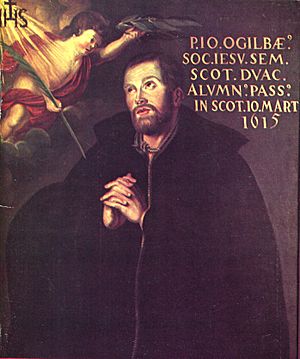John Ogilvie (saint) facts for kids
Quick facts for kids SaintJohn Ogilvie SJ |
|
|---|---|

John Ogilvie
|
|
| Born | 1580 Drumnakeith, Banffshire, Scotland |
| Died | 10 March 1615 (aged 34–35) Glasgow Cross, Scotland |
| Venerated in | Catholic Church |
| Beatified | 22 December 1929 |
| Canonized | 17 October 1976 |
| Feast | 10 March |
John Ogilvie, SJ (born 1580 – died 10 March 1615) was a Scottish Jesuit priest. He is known as a martyr, which means he died for his religious beliefs. He worked as a priest in Scotland during a time when being Catholic was against the law. Because he was hanged for his faith, he became the only Scottish saint after the time of the Reformation.
Ogilvie grew up in a different religion called Calvinism. He went to Europe for his education. There, he became interested in the discussions between Catholic and Calvinist thinkers. He decided to study with the Benedictines and then with the Jesuits. After becoming a Jesuit priest, he was sent back to Scotland. He secretly helped the few Catholics living near Glasgow. He was arrested in less than a year and was hanged in Glasgow in 1615.
Contents
Biography of John Ogilvie
John Ogilvie was the oldest son of Walter Ogilvie. His father was a respected Calvinist who owned land in Banffshire, Scotland. John's family had both Roman Catholic and Presbyterian members.
Early Life and Education
When John was twelve, he was sent to Europe to study. He went to several Catholic schools. He studied with the Benedictines in Regensburg, Germany. He also studied with the Jesuits in Olmutz and Brunn in Moravia.
Becoming a Catholic Priest
Europe at that time was full of religious arguments and changes. John decided to become a Catholic. In 1597, when he was seventeen, he officially joined the Catholic Church. This happened in Leuven, Belgium.
In 1599, Ogilvie joined the Society of Jesus, becoming a Jesuit. He became a priest in Paris in 1613. After becoming a priest, he worked in Rouen, France. He often asked to be sent to Scotland. He wanted to help the few Catholics still living in the Glasgow area. After 1560, it was against the law in Scotland to preach or support Catholicism.
Return to Scotland and Arrest
John hoped that some Catholic nobles in Scotland would help him because of his family background. When he found no one, he traveled to London, then back to Paris. Finally, in November 1613, he returned to Scotland. He pretended to be a horse trader named John Watson.
He began to preach in secret, holding Mass quietly in private homes. This work lasted less than a year. In October 1614, Ogilvie was found and arrested in Glasgow. This happened under the orders of Archbishop Spottiswood.
Trial and Execution
At first, he was treated well in prison. But he kept refusing to confess. So, he was tortured by being kept awake for a long time. He made his situation worse by refusing to promise loyalty to King James. He was tried for this crime.
During his trial, he spoke strongly against the King. He said he would not respect him as a ruler. He was found guilty. John Ogilvie was hanged at Glasgow Cross on 10 March 1615. He was thirty-six years old. People felt sorry for him, so his body was not further harmed after his death. He was quickly buried in the churchyard of Glasgow Cathedral.
Last Words and Legacy
John Ogilvie's last words were: "If there be here any hidden Catholics, let them pray for me but the prayers of heretics I will not have." As he was pushed from the stairs, he threw his hidden rosary into the crowd. A story says that one of his enemies caught it and later became a strong Catholic for life. After his death, Ogilvie's followers were arrested and put in jail. They had to pay large fines, but none of them were sentenced to death.
Remembering John Ogilvie
John Ogilvie is remembered as a martyr of the Scottish Reformation and the Counter-Reformation. He was declared "Venerable" in the 1600s. This is an important step in becoming a saint.
Becoming a Saint
Ogilvie was beatified in 1929. This is the second step towards sainthood. He was then canonised (made a saint) on 17 October 1976. He became the only Scottish saint from after the Reformation period.
Feast Day and Churches
His feast day is celebrated on 10 March by the Catholic Church in Scotland. In other parts of the world, it is celebrated on 14 October.
In Corby, England, a town with many Scottish people, a Catholic church was named after Saint John Ogilvie in 1980. In the Scottish Highlands, there is a group of churches called the Parish of Saint John Ogilvie. These include Saint Joseph’s Church in Invergordon and Saint Vincent De Paul’s Church in Tain. At a service marking 400 years since his death, he was called "Scotland's only Catholic martyr."
See also
- George Wishart
- List of Protestant martyrs of the Scottish Reformation
- Forty Martyrs of England and Wales
- List of Catholic martyrs of the English Reformation
- John Black (martyr)
- George Douglas (martyr)
- William Gibson (martyr)
- John Ingram (martyr)
- Patrick Primrose
- Hugh Barclay of Ladyland, David Graham, Laird of Fintry, Spanish blanks plot
- Alexander Cameron (priest)
- Saint John Ogilvie, patron saint archive
Sources

